| Quilt History
Today's Quilt Historians Underground Railroad
Women at Work
| New Pathways into Quilt History written by Kimberly Wulfert, www.antiquequiltdating.com
String Quilts Match the Economic Times, Past and Present
by Kimberly Wulfert, PhD | 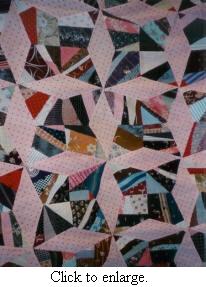 During the economic slump of the early twentieth century, string style quilt making thrived. Rural mid-century women, cut off from mainstream society and markets, founded their own string quilt style. The twenty-first century version is known as selvedge edge quilts.* During the economic slump of the early twentieth century, string style quilt making thrived. Rural mid-century women, cut off from mainstream society and markets, founded their own string quilt style. The twenty-first century version is known as selvedge edge quilts.*
The strings were narrow strips of scrap fabrics or otherwise used pieces of fabric that would be thrown out. String quilts knew no bounds. Women sewed their strips of fabric together until they covered a pattern in the shape of a diamond, square, triangle or any shape cut from newspaper or used fabric.
Women made strings from used, old, and new fabrics. All fibers and thread counts were candidates for the string quilt including the thinnest dress fabrics. Often, a flour sack served as the foundation fabric for sewing string pieces onto, in the flip-and-sew fashion, until the foundation was covered. They snipped off fabric leftover around the pattern edges, and the blocks were sewn together as any patchwork block would be. As a result, some string quilts offer a cacophony of fabrics not often used in quilts.
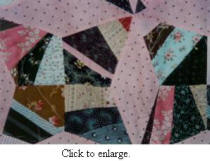 Some women used larger scraps, and often the block's strips were a variety of widths. Scrappy strips were asymmetrical and uneven, or pointed, or on the bias. Whatever fabrics were available, they were used as is. There was no time to waste cutting them to size. Women used an old blanket or quilt as the filler and tied the layers together; winter was near -- no time for quilting it. Some women used larger scraps, and often the block's strips were a variety of widths. Scrappy strips were asymmetrical and uneven, or pointed, or on the bias. Whatever fabrics were available, they were used as is. There was no time to waste cutting them to size. Women used an old blanket or quilt as the filler and tied the layers together; winter was near -- no time for quilting it.

String quilts made by women in Gee's Bend, Alabama, (scroll down to the 3rd quilt for a larger view ) and Mid-western Amish communities, have become an art form. Their stringed blocks are often square in shape or close to it, with one above the other. Sometimes sashing strips divide the blocks. The Amish string quilts can look like stacks of small squares. This pattern is named Coins.
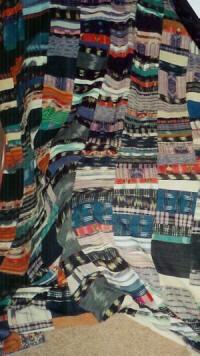
When these noted groups of quilters combined their scraps into a string quilt, it may have been nothing special to them. Yet, the quilts dazzle the eyes of outsiders and art collectors who see them as wall art today. When the country was enduring the Great Depression, women combined their scraps into string quilts, which were seen as utilitarian and still are.
Now, women are making selvedge edge quilts, using strips cut from the sides or edges of cotton fabric. The selvedge prevents unraveling and holds onto hooks during the printing process. This edge is mostly white with the manufacturer’s name and logo, the designer or collection’s name, and a chart of the colors used printed on it. Selvedge edges are cut completely off and thrown away. Today, they are saved for a new purpose.
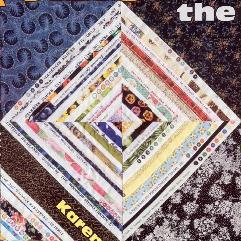 Selvedge edges are about one-half inch in width and run the length of the bolt. The writing on the edge varies in font style, color, and amount of coverage. This then becomes the decoration on this strip. The selvedge edge's size and shape matches another material women used a century ago that was definitely not intended for quilt makers, but instead was a by-product of cigar companies. Selvedge edges are about one-half inch in width and run the length of the bolt. The writing on the edge varies in font style, color, and amount of coverage. This then becomes the decoration on this strip. The selvedge edge's size and shape matches another material women used a century ago that was definitely not intended for quilt makers, but instead was a by-product of cigar companies.
A century ago, cigar companies tied a bright colored silk ribbon around a bundle of cigars. Women stitched them together with black or colored embroidery floss stitches onto a fabric foundation block. They were not cut or curved, but placed side by side. Cigar company ribbons had fancy logos and used attractive fonts in black ink on yellow or orange ribbons. The various advertising on the ribbons added decoration to the quilt block. Green, pink and purple ribbons were occasionally used in the block designs, signifying a rare cigar.
Just as with many string and selvedge edge quilt blocks, women took the cigar ribbons and arranged them to form designs. The blocks were usually square, with strips laid in log cabin designs, on the diagonal, or in quartered designs. The color would add another dimension as the secondary pattern that formed when the blocks were sewn together.
Seldom were cigar ribbon tops made into quilts with batting and back. Made with silk and unquilted, they were fragile, unlike the string and selvedge edge quilts. Mostly they remained as tops to cover tables, or they were made into pillows.
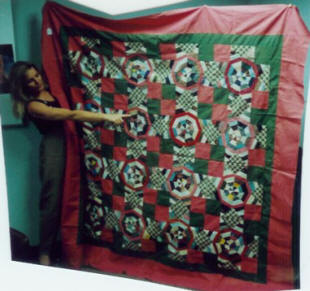 The common thread in string, selvedge edge, and cigar ribbon tops, is that their popularity came about at the time of an economic downturn or a War, or both. The materials used in each were throw-aways being put to use, as a quilt or decoration for women's homes, and they were there for the taking. The common thread in string, selvedge edge, and cigar ribbon tops, is that their popularity came about at the time of an economic downturn or a War, or both. The materials used in each were throw-aways being put to use, as a quilt or decoration for women's homes, and they were there for the taking.
Women did then as they do now -- they got creative and sewed together the fabrics they had, including scraps. New quilt styles emerged that we recognize today and hold dear in our homes, or see exhibited in a gallery as art.
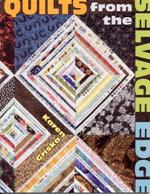
*This term may have been coined by the Karen Griska who authored a how-to book, “Quilts From the Selvage Edge”, AQS, 2008. Selvage or selvedge is correctly spelled either way. | * Quilts
© 2008 - 2022 Kimberly Wulfert, PhD. Absolutely no copies, reprints, use of photos or text are permitted for commercial or online use. One personal copy for study purposes is permitted.
|
Fabrics & Dyes
Rugs & Textiles
Books & Reviews
Resource Links
Home
|